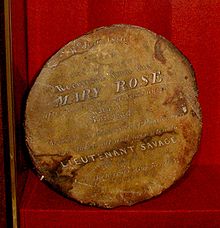- John Deane (inventor)
-
Charles and John Deane (1800–1884; known as The Infernal Diver) were the inventors of the diving helmet, and performed diving operations at the wreck of the Mary Rose.[1] The brothers received their education at The Royal Hospital School, Greenwich, and were both in attendance in 1812. When he was 14 years old John joined the East India Company, and sailed with them for seven years.
In the 1820's John Deane was present in England when horses were trapped by fire in a stable. To get through the smoke and fire fumes he put on a medieval knight-in-armor helmet air-pumped by hose from a fire brigade water pump, and rescued all the horses. [2] In 1823 he patented a "Smoke Helmet" to be used by firemen in smoke-filled areas; the full title is given as "Apparatus or Machines to be worn by Persons entering Rooms or other places filled with Smoke of other Vapour, for the purpose of extinguishing Fire, or extricating Persons or Property therein". The apparatus comprised a copper helmet with an attached flexible collar and garment. A long leather hose attached to the rear of the helmet was to be used to supply air, the original concept being that it would be pumped using a double bellows. A short pipe allowed breathed air to escape. The garment was to be constructed from leather or airtight cloth, secured by straps.
Later this was developed into a diving apparatus: see Charles Anthony Deane.
In 1829 the Deane brothers sailed from Whitstable for trials of their new underwater apparatus, establishing the diving industry in the town.
In 1830 John Deane and his diving partner, George Bell, salvage of the cannons from the wreck of the Guernsey Lily. One of these cannons is now located at Quex Park, Birchington.
On 16 June 1836 the Mary Rose shipwreck was discovered when a fishing net caught on the wreck. John Deane, and his partner William Edwards, recovered timbers, guns, longbows, and other items from the shipwreck. The location of the shipwreck was forgotten after John Deane stopped work on the site of the Mary Rose shipwreck in 1840.
William Edwards was John Deane's partner between 1834 and 1855. Edwards died in the Crimea during the 1854-6 war.
George Hall was the bell diver who collaborated with the Deanes in the development of their diving apparatus. He is credited with first teaching the Royal Sappers & Miners and Royal Engineers to dive during the salvage of the Royal George, 1839-40.
John Deane is known to have given a series of lectures in 1847 on "diving and submarine operations" at the Assembly Rooms in Whitstable. Charles and John Deane exhibited their invention in the Great Exhibition of 1851.
John Deane, working for the Admiralty, cleared the Russian wrecks from Sevastapol harbour during the Crimea War. Sarah Ann Browning managed John Deane's business affairs when he was working in the Crimea between 1854 and 1856.
John Deane married Sarah Ann Browning at St Alphege Church, Whitstable, in October 1856 on his return from the Crimean War. Sarah Deane, John Deane's second wife is buried at Millstroode Cemetery, Whitstable.
John Deane died in 1884 and was buried in Ramsgate.
References
- ^ The Infernal Diver by John Bevan, Hardcover - 314 pages (27 May 1996), Submex Ltd; ISBN 0950824216
- ^ http://scubaeds.com/10.html Scuba Ed's - History of scuba diving

This article about an engineer, inventor or industrial designer from the United Kingdom or its predecessor states is a stub. You can help Wikipedia by expanding it.

